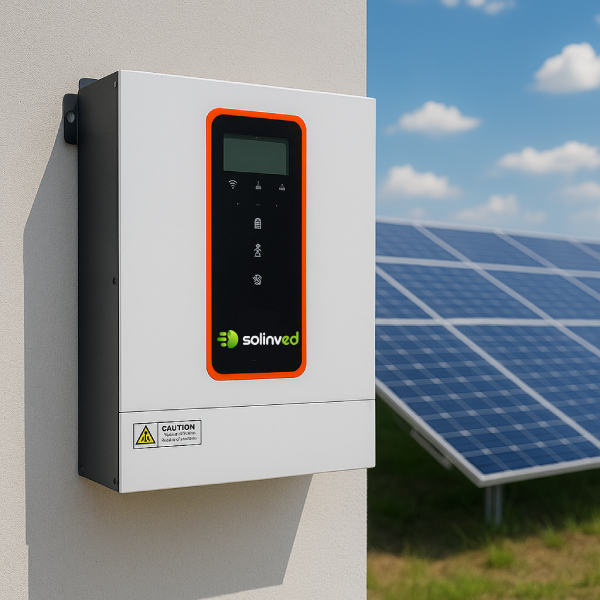


Solar energy systems are one of the most important building blocks of sustainable energy production. However, solar panels alone do not produce electricity usable in homes or businesses. This is because panels produce direct current (DC), whereas all the electrical devices we use in our daily lives operate on alternating current (AC).
The critical component that enables this conversion is the inverter. In other words, the inverter is not just a converter; it is also the heart of the energy.
Solinved seamlessly integrates smart inverter technologies that aim for maximum efficiency in solar energy systems, ensuring both energy conversion and energy management.
In this article, we will examine in detail why inverters are needed, how they work, and the differences between Solinved's inverter technologies.
An inverter is a device that converts DC (direct current) electricity from solar panels into AC (alternating current) electricity used in the grid.
Simply put, an inverter converts the electricity from solar panels into usable electricity for devices like refrigerators, televisions, air conditioners, and industrial motors in your home.
However, modern inverters don't just convert energy.
Solinved's smart inverters:
Optimize energy production
Perform efficiency analyses
Provide overload, voltage, or temperature protection
Offer remote monitoring and management.
Solar panels produce direct current (DC) when converting sunlight into electrical energy. Electrical devices used in homes and businesses operate on alternating current (AC).
Inverters eliminate the difference between these two current types.
By converting DC to AC, they enable the use of solar energy in daily life.
Solinved inverters achieve this conversion with minimal loss, achieving maximum efficiency (up to 98%).
Each solar panel produces a different amount of energy depending on sunlight, temperature, and shading conditions. This variability can reduce system efficiency.
Inverters detect the maximum power point of each panel using MPPT (Maximum Power Point Tracking) technology. This continuously optimizes panel efficiency.
The result: Up to 20% more energy is obtained from the same panel area.
Modern inverters not only convert energy; they also manage how the energy is used in the system. Solinved smart inverters can distribute the generated energy in three different directions:
Instantaneous energy consumption,
Battery storage,
Energy transfer to the grid.
In this way, the inverter becomes the center of smart energy management.
For solar energy systems to work seamlessly with the public grid, the system's frequency, voltage, and phase values must match the grid.
The inverter is the device that enables this synchronization. On-grid inverters transfer excess energy to the grid while simultaneously protecting the security of the system.
Not only is energy generated important, but it's also stored when needed. Solinved hybrid inverters are fully compatible with lithium battery systems, storing excess energy.
Energy generated during the day is stored and used in the evening or on days when the sun isn't shining. This allows users to have off-grid energy.
Power fluctuations, overloads, or voltage spikes can damage system components. In these cases, the inverter regulates the current and maintains it at a safe level.
Solinved inverters provide long-lasting and stable energy flow with safety features such as:
Overheating protection,
Short circuit protection,
Voltage unbalance protection,
and so on.
Solinved offers specialized inverter solutions for solar energy systems of various sizes:
| Inverter Type | Description | Application Area |
|---|---|---|
| On-Grid Inverter | Can sell excess energy in grid-connected systems. | Home, office, commercial facilities |
| Off-Grid Inverter | Can operate with batteries in off-grid systems. | Agriculture, rural areas, irrigation systems |
| Hybrid (Smart) Inverter | Can operate both grid-connected and battery-backed. | Home and industrial systems, EV charging stations |
| Solar Drive Integrated Inverter | Works integrated with agricultural irrigation pumps. | Agricultural energy management |
All Solinved inverters are equipped with MPPT technology, remote monitoring, high efficiency, and safety standards.
High Conversion Efficiency: Up to 98% energy conversion rate for increased production and reduced power loss.
Lithium Battery Integration: Fully compatible with Solinved lithium batteries.
Remote Monitoring and Smart Management: Users can monitor system performance instantly via mobile or web applications.
High-Level Security: All models feature overvoltage, temperature, and short circuit protection.
Smart MPPT Technology: Ensures maximum production by monitoring individual power points for each panel array.
If a solar energy system is installed without an inverter:
Panels produce DC current, but household appliances cannot use this electricity.
Energy cannot be directly transferred to the grid.
Battery and energy management are not possible.
System efficiency decreases significantly.
In short, a solar energy system without an inverter is nothing more than a missing core.
Solinved inverters not only generate electricity; they also act as a management center that intelligently manages energy.
By working integrated with solar panels, batteries, and solar drives, they offer users maximum energy efficiency, complete security, and long-lasting performance.
Solinved's technological vision:
"Converting every drop of sunlight into smart energy."
1. Can solar panels operate without an inverter?
No. Even if the panels generate energy, this energy cannot be used without an inverter.
2. What is the lifespan of an inverter?
High-quality inverters operate efficiently for 10–15 years. Solinved models are at the upper end of this range.
3. What is an MPPT inverter?
MPPT is a technology that tracks the maximum power point of panels. It provides the highest energy production.
4. Does the inverter require maintenance?
No significant maintenance is required other than periodic inspections and software updates.
5. Are Solinved inverters compatible with other brands?
Yes, Solinved inverters can be integrated with panels and batteries from different brands.